The PaleozoicEra is the first of three geological eras of the Phanerozoic Eon. Beginning 538.8 million years ago (Ma), it succeeds the Neoproterozoic and ends 251.9 Ma at the start of the Mesozoic Era. The Paleozoic is subdivided into six geologic periods, Cambrian, Ordovician, Silurian, Devonian, Carboniferous and Permian. Some geological timescales divide the Paleozoic informally into early and late sub-eras: the Early Paleozoic consisting of the Cambrian, Ordovician and Silurian; the Late Paleozoic consisting of the Devonian, Carboniferous and Permian.

The Principality of Sealand is a micronation on HM Fort Roughs, an offshore platform in the North Sea. It is situated on Rough Sands, a sandbar located approximately 11 kilometres (6 nmi) from the coast of Suffolk and 13 kilometres (7 nmi) from the coast of Essex. Roughs Tower is a Maunsell Sea Fort that was built by the British in international waters during World War II. Since 1967, the decommissioned Roughs Tower has been occupied and claimed as a sovereign state by the family and associates of Paddy Roy Bates. Bates seized Roughs Tower from a group of pirate radio broadcasters in 1967 with the intention of setting up his own station there. Bates and his associates have repelled incursions from vessels from rival pirate radio stations and the UK's Royal Navy using firearms and petrol bombs. In 1987, the United Kingdom extended its territorial waters to 12 nautical miles, which places the platform in British territory. As of August 2024, Sealand has only one permanent resident.

Bryophytes are a group of land plants (embryophytes), sometimes treated as a taxonomic division, that contains three groups of non-vascular land plants: the liverworts, hornworts, and mosses. In the strict sense, the division Bryophyta consists of the mosses only. Bryophytes are characteristically limited in size and prefer moist habitats although some species can survive in drier environments. The bryophytes consist of about 20,000 plant species. Bryophytes produce enclosed reproductive structures, but they do not produce flowers or seeds. They reproduce sexually by spores and asexually by fragmentation or the production of gemmae.

The Marchantiophyta are a division of non-vascular land plants commonly referred to as hepatics or liverworts. Like mosses and hornworts, they have a gametophyte-dominant life cycle, in which cells of the plant carry only a single set of genetic information.
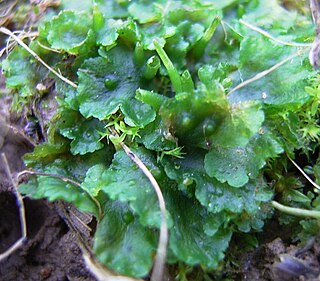
Hornworts are a group of non-vascular Embryophytes constituting the division Anthocerotophyta. The common name refers to the elongated horn-like structure, which is the sporophyte. As in mosses and liverworts, hornworts have a gametophyte-dominant life cycle, in which cells of the plant carry only a single set of genetic information; the flattened, green plant body of a hornwort is the gametophyte stage of the plant.

Baltica is a paleocontinent that formed in the Paleoproterozoic and now constitutes northwestern Eurasia, or Europe north of the Trans-European Suture Zone and west of the Ural Mountains. The thick core of Baltica, the East European Craton, is more than three billion years old and formed part of the Rodinia supercontinent at c. 1 Ga.
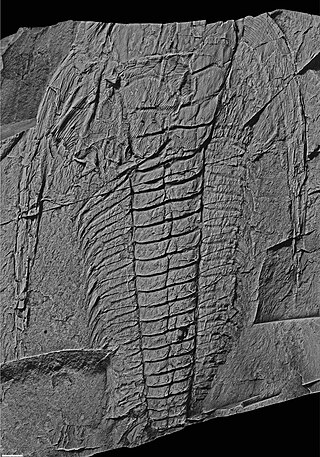
John William Salter was an English naturalist, geologist, and palaeontologist.
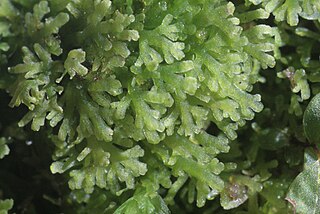
Metzgeriales is an order of liverworts. The group is sometimes called the simple thalloid liverworts: "thalloid" because the members lack structures resembling stems or leaves, and "simple" because their tissues are thin and relatively undifferentiated. All species in the order have a small gametophyte stage and a smaller, relatively short-lived, spore-bearing stage. Although these plants are almost entirely restricted to regions with high humidity or readily available moisture, the group as a whole is widely distributed, and occurs on every continent except Antarctica.

The Diaphanopterodea or Paramegasecoptera are an extinct order of moderate to large-sized Palaeozoic insects. They are first known from the Middle Carboniferous, and include some of the earliest known flying insects.

Pantylus is an extinct microsaurian tetrapod from the Permian period of North America.
The geology of Illinois includes extensive deposits of marine sedimentary rocks from the Palaeozoic, as well as relatively minor contributions from the Mesozoic and Cenozoic. Ice age glaciation left a wealth of glacial topographic features throughout the state.

Sphagnopsida is a class of mosses that includes a single subclass Sphagnidae, with two orders. It is estimated it originated about 465 million years ago, along with Takakia. The order Sphagnales contains four living genera: Ambuchanania, Eosphagnum, and Flatbergium, which counts four species in total, and Sphagnum which contains the rest of the species. The extinct Protosphagnales contains a single fossil species.
Protosphagnum nervatum is the only known species of order Protosphagnales. It is only known from the Permian fossil record. In many ways, it resembles the living moss genus Sphagnum, though its leaf cells are not as strongly dimorphic as in Sphagnum.
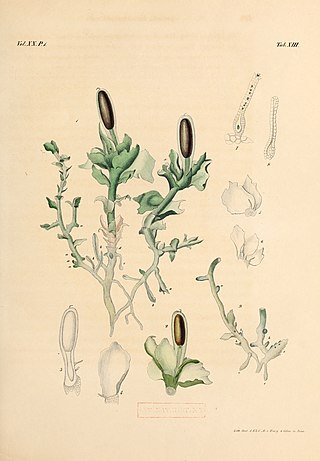
Haplomitriopsida is a class of liverworts comprising fifteen species in three genera. Recent cladistic analyses of nuclear, mitochondrial, and plastid gene sequences place this monophyletic group as the basal sister group to all other liverworts. The group thus provides a unique insight into the early evolution of liverworts in particular and of land plants in general.
Treubiites kidstonii is a fossil species of liverworts in the family Treubiitaceae. The only known fossils come from Late Carboniferous deposits of Shropshire, England.

Petalodus is an extinct genus of cartilaginous fish from the Pennsylvanian to the Permian, known from subtriangular to rhomboidal teeth. The genus was named by Richard Owen in 1840 and the type species is Petalodus hastingsii. The only dubious species within this genus is P. securiger.

John Albert Long is an Australian paleontologist who is currently Strategic Professor in Palaeontology at Flinders University in Adelaide, South Australia. He was previously the Vice President of Research and Collections at the Natural History Museum of Los Angeles County. He is also an author of popular science books. His main area of research is on the fossil fish of the Late Devonian Gogo Formation from northern Western Australia. It has yielded many important insights into fish evolution, such as Gogonasus and Materpiscis, the later specimen being crucial to our understanding of the origins of vertebrate reproduction.
Basilochelys is an extinct genus of land turtle which existed during the early Cretaceous period (Berriasian). Containing the sole species Basilochelys macrobios, its fossils have been found in the Phu Kradung Formation of Northeast Thailand. It is considered to be the most basal member of the group Trionychoidae.
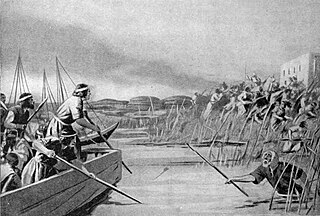
The First Sealand dynasty (URU.KÙKI), or the 2nd Dynasty of Babylon, very speculatively c. 1732–1460 BC, is an enigmatic series of kings attested to primarily in laconic references in the king lists A and B, and as contemporaries recorded on the Assyrian Synchronistic king list A.117. Initially it was named the "Dynasty of the Country of the Sea" with Sealand later becoming customary.

Amphissites is an extinct genus of ostracod belonging to the suborder Beyrichicopina and family Amphissitinae. Species belonging to the genus lived from the Devonian to the Permian in Europe, North America, Australia, and east Asia. The genus were likely deposit-feeders, and may have survived briefly into the Triassic.














